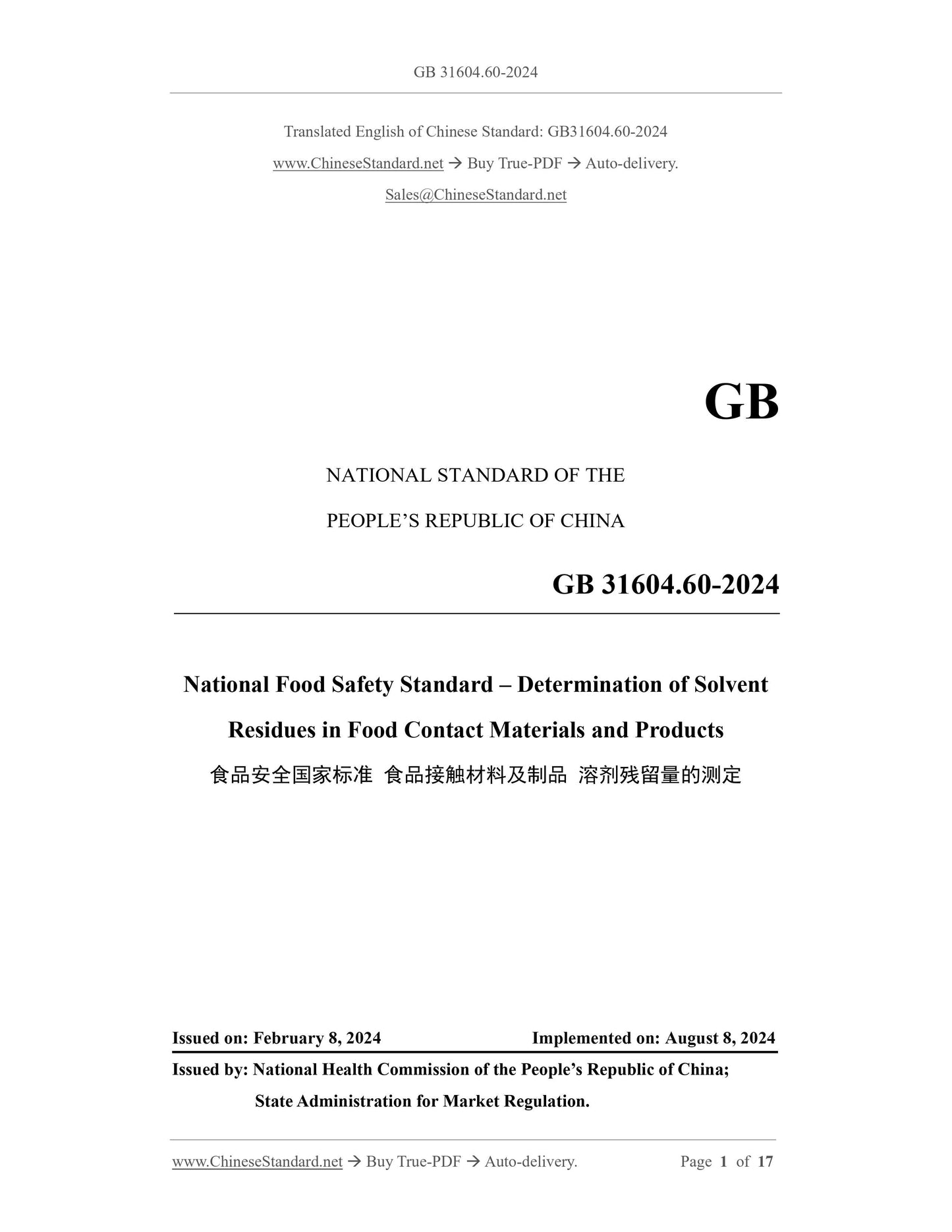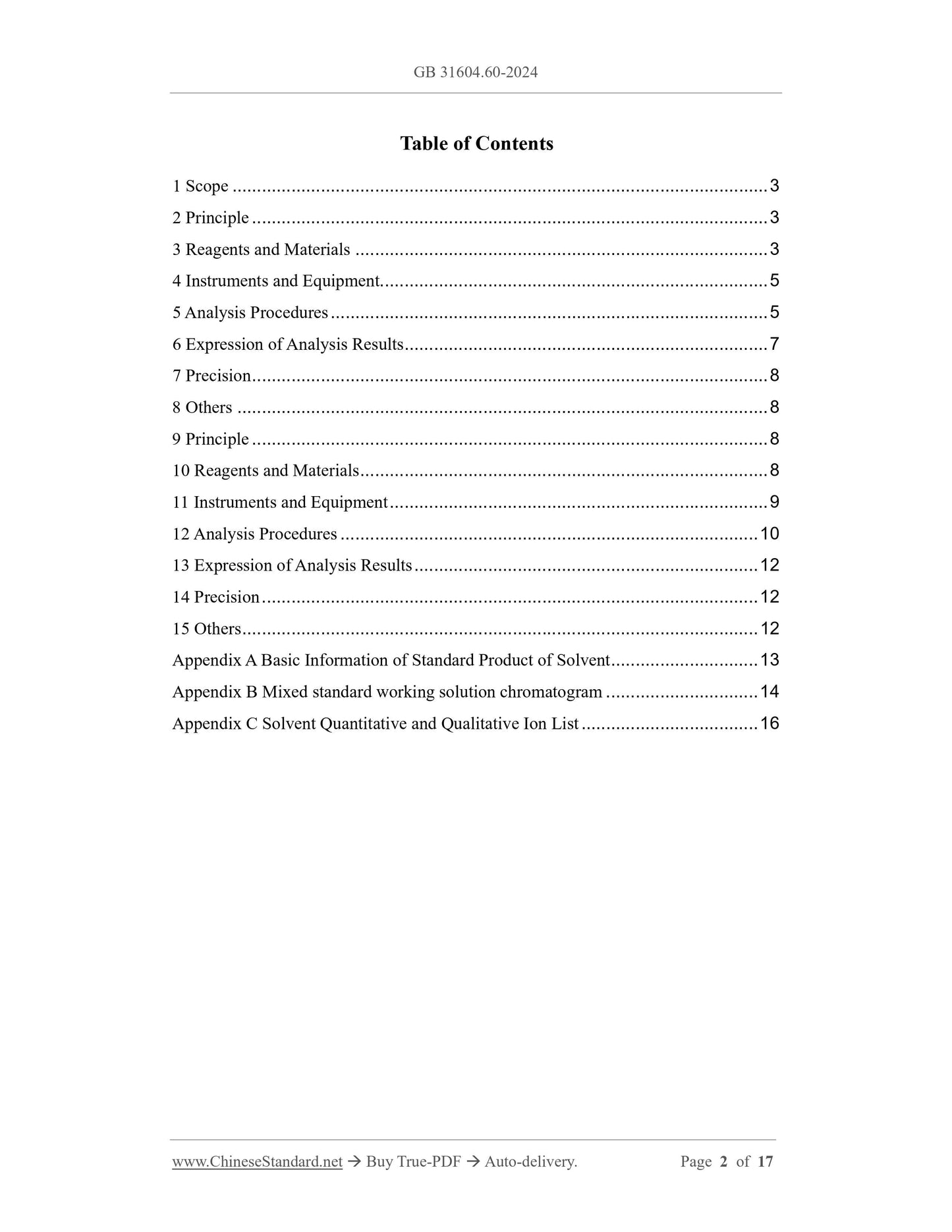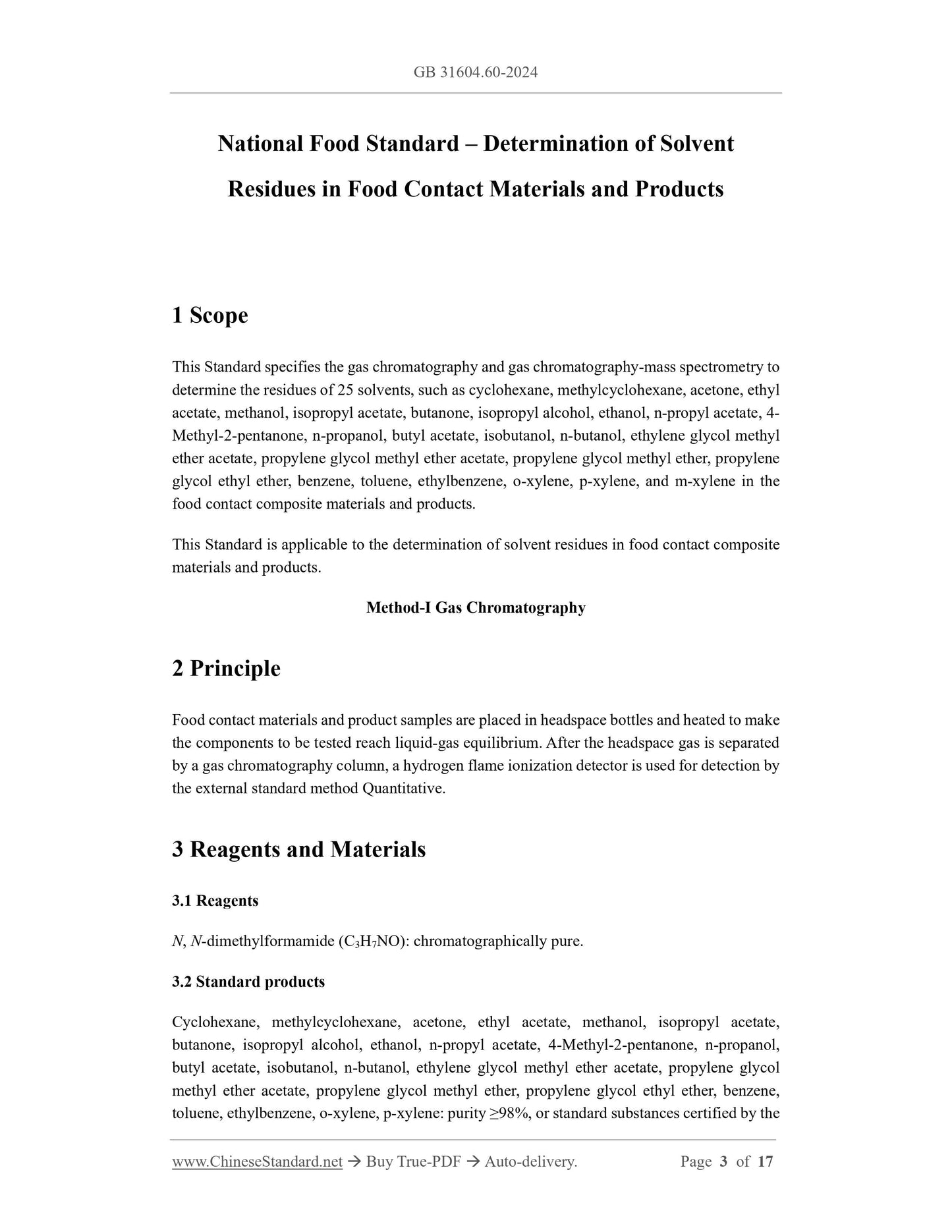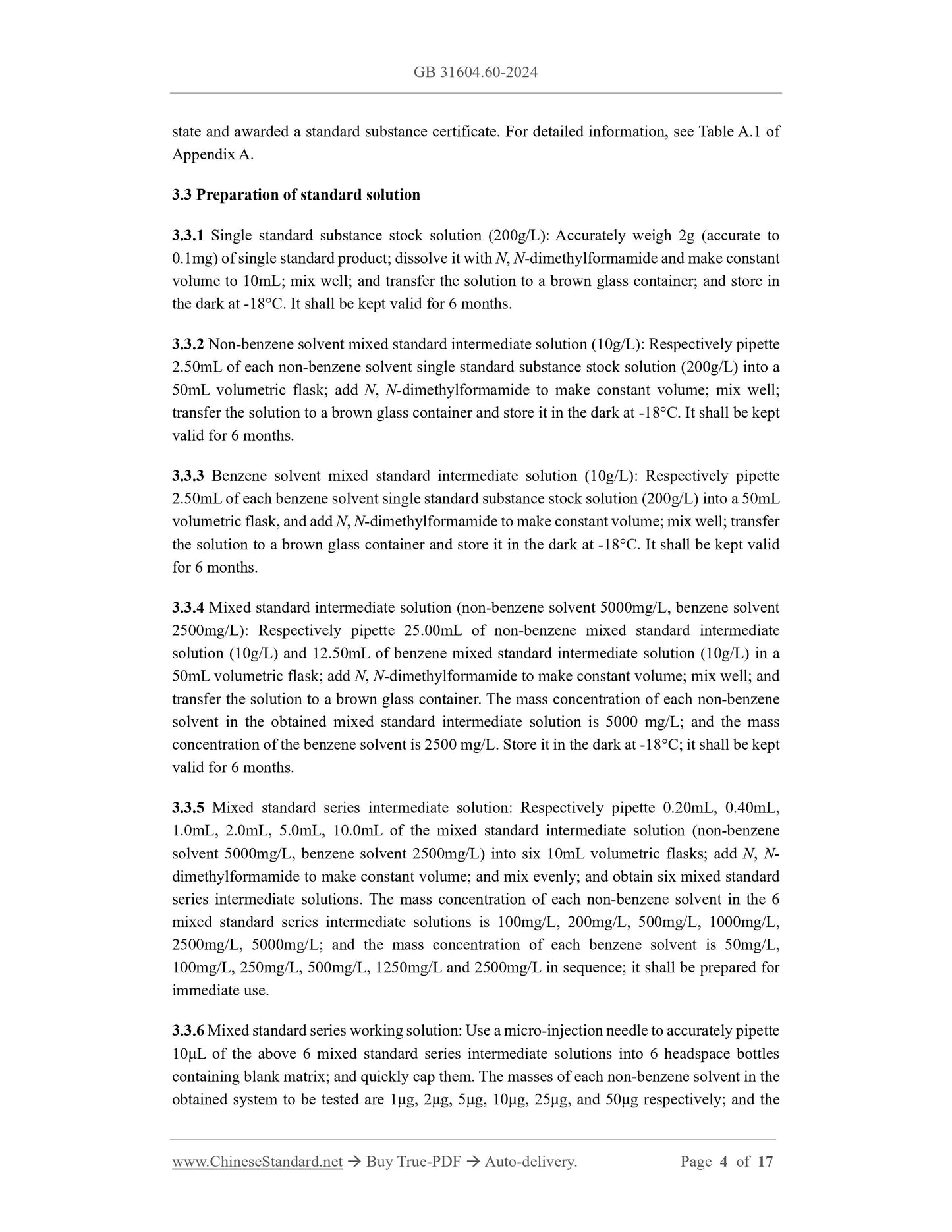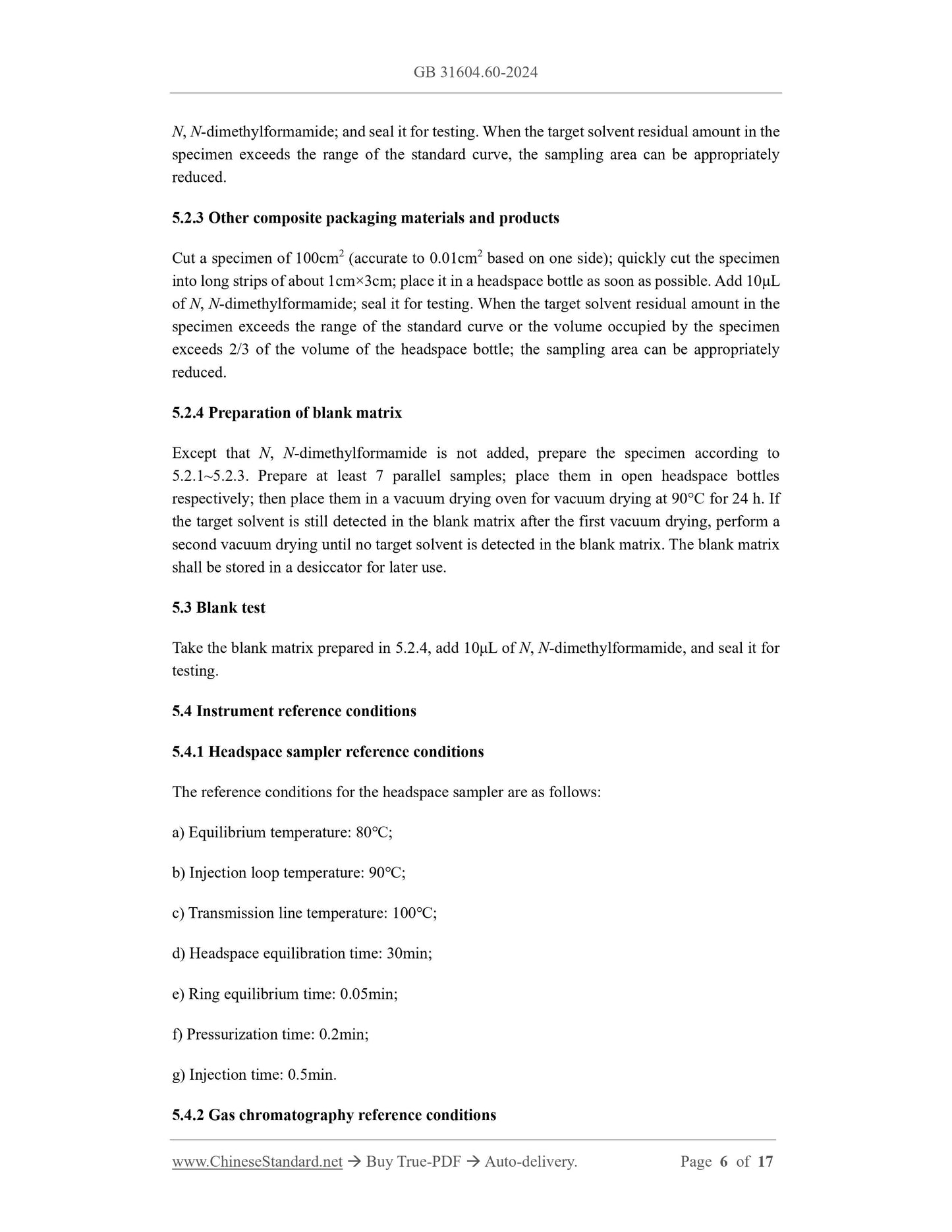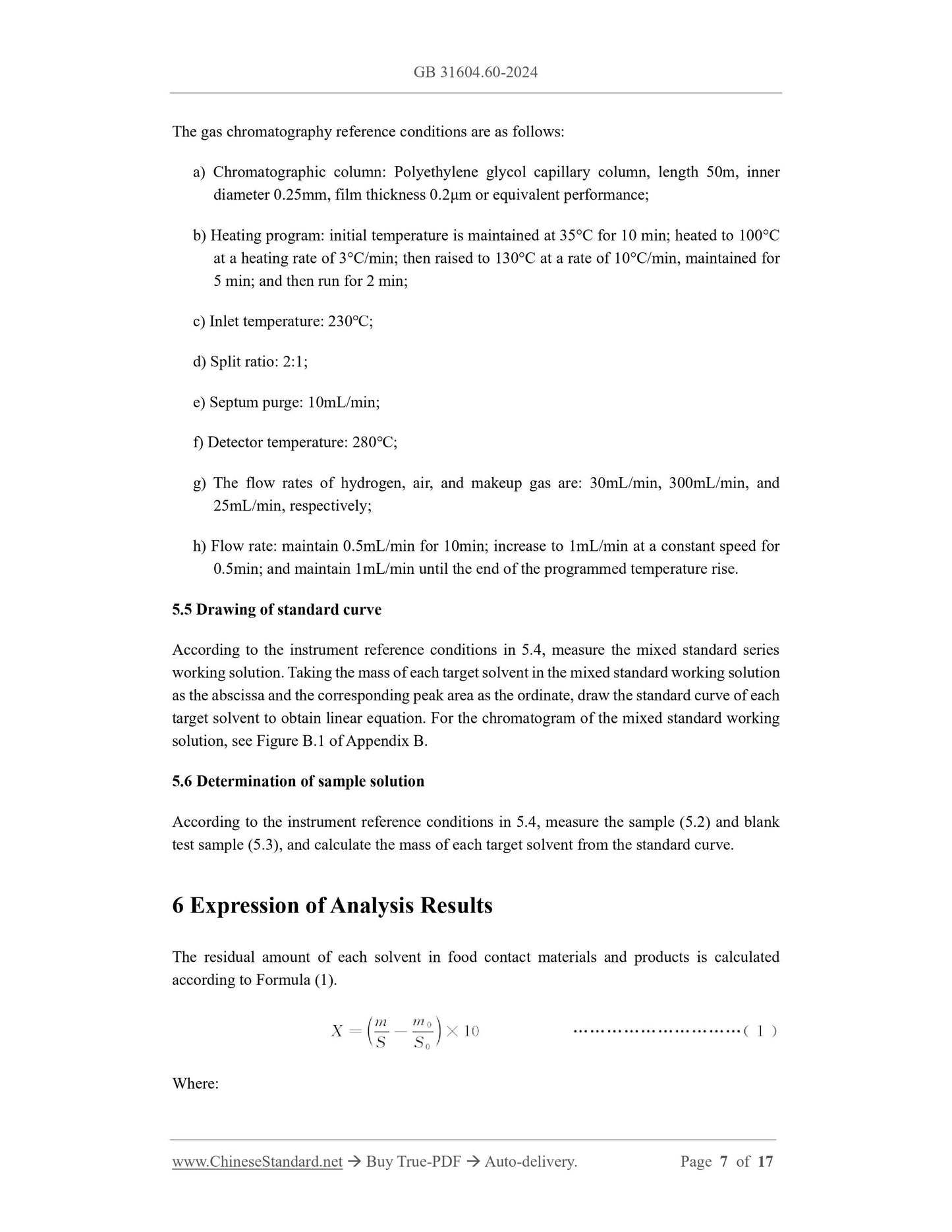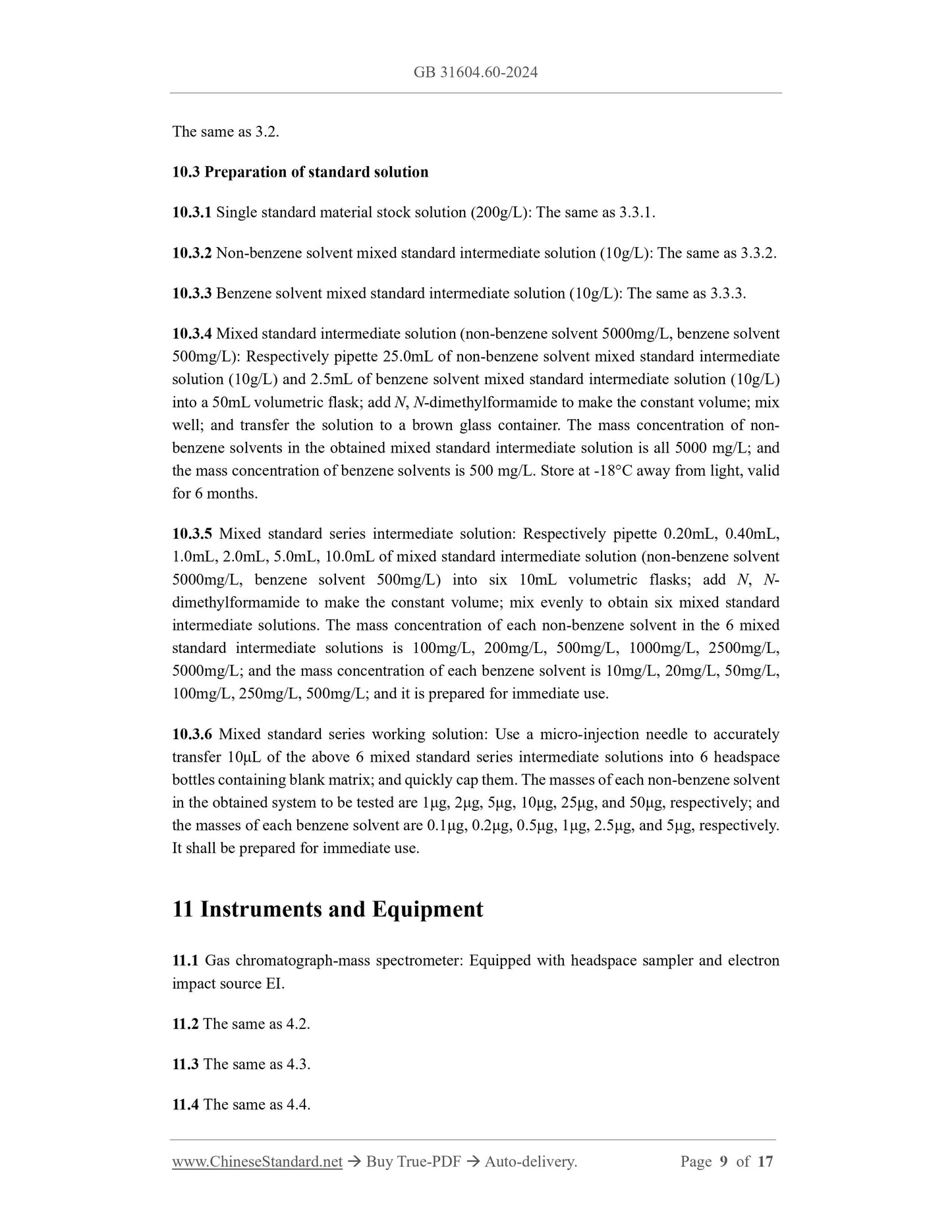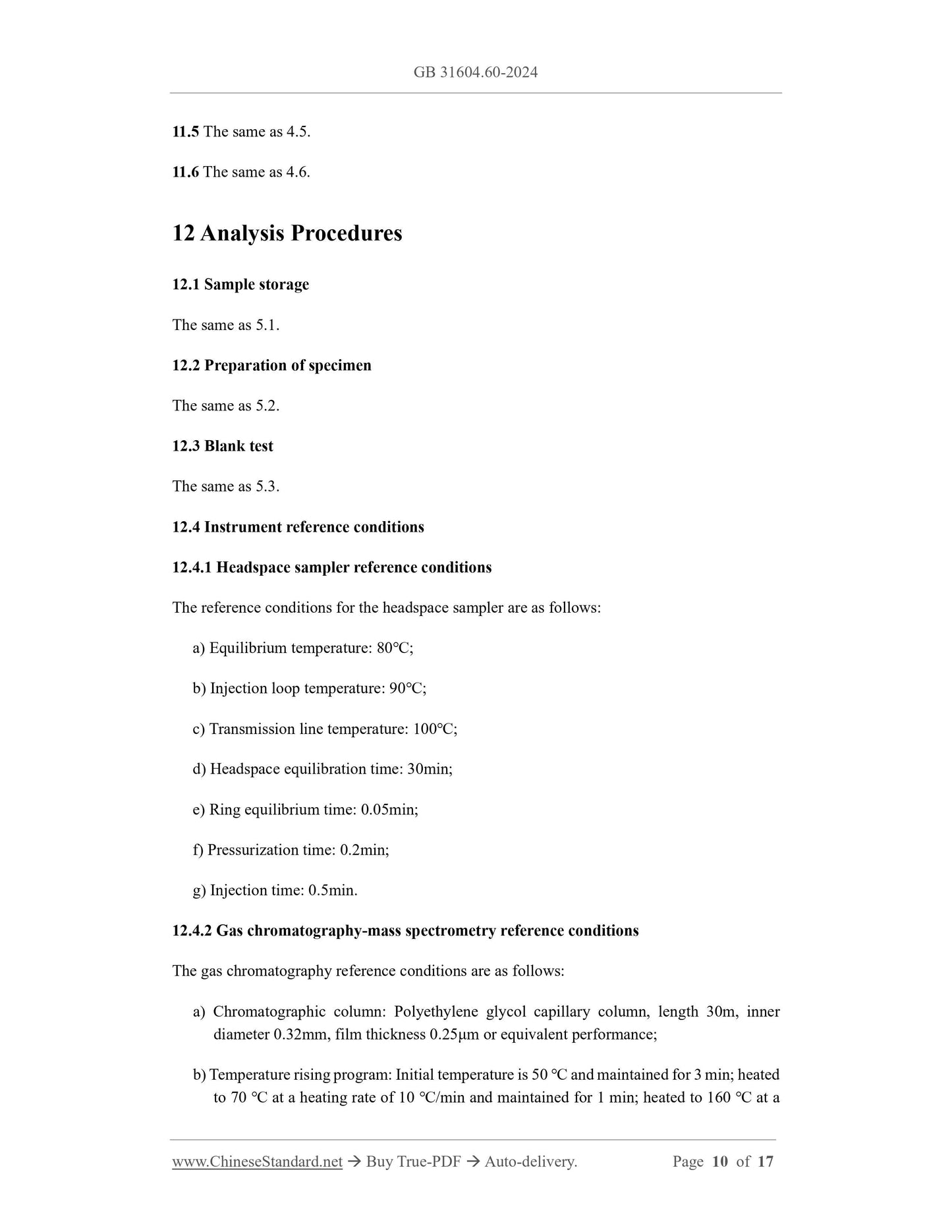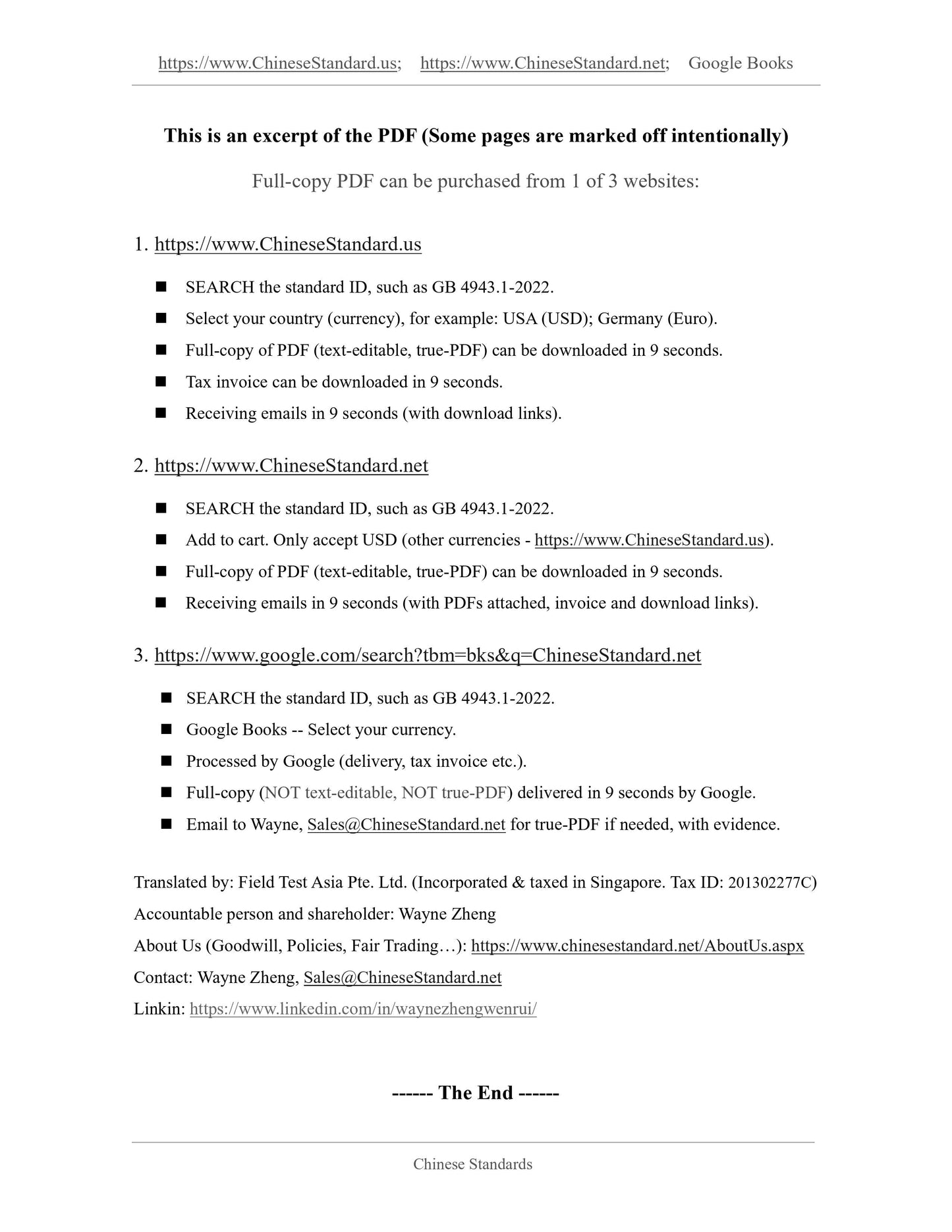1
/
of
9
PayPal, credit cards. Download editable-PDF and invoice in 1 second!
GB 31604.60-2024 English PDF
GB 31604.60-2024 English PDF
Regular price
$215.00 USD
Regular price
Sale price
$215.00 USD
Unit price
/
per
Shipping calculated at checkout.
Couldn't load pickup availability
Delivery: 3 seconds. Download true-PDF + Invoice.
Get QUOTATION in 1-minute: Click GB 31604.60-2024
Historical versions: GB 31604.60-2024
Preview True-PDF (Reload/Scroll if blank)
GB 31604.60-2024: National food safety standards--Determination of solvent residues in food contact materials and products
GB 31604.60-2024
GB
NATIONAL STANDARD OF THE
PEOPLE’S REPUBLIC OF CHINA
National Food Safety Standard – Determination of Solvent
Residues in Food Contact Materials and Products
ISSUED ON: FEBRUARY 8, 2024
IMPLEMENTED ON: AUGUST 8, 2024
Issued by: National Health Commission of the People’s Republic of China;
State Administration for Market Regulation.
Table of Contents
1 Scope ... 3
2 Principle ... 3
3 Reagents and Materials ... 3
4 Instruments and Equipment... 5
5 Analysis Procedures ... 5
6 Expression of Analysis Results ... 7
7 Precision ... 8
8 Others ... 8
9 Principle ... 8
10 Reagents and Materials ... 8
11 Instruments and Equipment ... 9
12 Analysis Procedures ... 10
13 Expression of Analysis Results ... 12
14 Precision ... 12
15 Others ... 12
Appendix A Basic Information of Standard Product of Solvent ... 13
Appendix B Mixed standard working solution chromatogram ... 14
Appendix C Solvent Quantitative and Qualitative Ion List ... 16
National Food Standard – Determination of Solvent
Residues in Food Contact Materials and Products
1 Scope
This Standard specifies the gas chromatography and gas chromatography-mass spectrometry to
determine the residues of 25 solvents, such as cyclohexane, methylcyclohexane, acetone, ethyl
acetate, methanol, isopropyl acetate, butanone, isopropyl alcohol, ethanol, n-propyl acetate, 4-
Methyl-2-pentanone, n-propanol, butyl acetate, isobutanol, n-butanol, ethylene glycol methyl
ether acetate, propylene glycol methyl ether acetate, propylene glycol methyl ether, propylene
glycol ethyl ether, benzene, toluene, ethylbenzene, o-xylene, p-xylene, and m-xylene in the
food contact composite materials and products.
This Standard is applicable to the determination of solvent residues in food contact composite
materials and products.
Method-I Gas Chromatography
2 Principle
Food contact materials and product samples are placed in headspace bottles and heated to make
the components to be tested reach liquid-gas equilibrium. After the headspace gas is separated
by a gas chromatography column, a hydrogen flame ionization detector is used for detection by
the external standard method Quantitative.
3 Reagents and Materials
3.1 Reagents
N, N-dimethylformamide (C3H7NO): chromatographically pure.
3.2 Standard products
Cyclohexane, methylcyclohexane, acetone, ethyl acetate, methanol, isopropyl acetate,
butanone, isopropyl alcohol, ethanol, n-propyl acetate, 4-Methyl-2-pentanone, n-propanol,
butyl acetate, isobutanol, n-butanol, ethylene glycol methyl ether acetate, propylene glycol
methyl ether acetate, propylene glycol methyl ether, propylene glycol ethyl ether, benzene,
toluene, ethylbenzene, o-xylene, p-xylene: purity ≥98%, or standard substances certified by the
state and awarded a standard substance certificate. For detailed information, see Table A.1 of
Appendix A.
3.3 Preparation of standard solution
3.3.1 Single standard substance stock solution (200g/L): Accurately weigh 2g (accurate to
0.1mg) of single standard product; dissolve it with N, N-dimethylformamide and make constant
volume to 10mL; mix well; and transfer the solution to a brown glass container; and store in
the dark at -18°C. It shall be kept valid for 6 months.
3.3.2 Non-benzene solvent mixed standard intermediate solution (10g/L): Respectively pipette
2.50mL of each non-benzene solvent single standard substance stock solution (200g/L) into a
50mL volumetric flask; add N, N-dimethylformamide to make constant volume; mix well;
transfer the solution to a brown glass container and store it in the dark at -18°C. It shall be kept
valid for 6 months.
3.3.3 Benzene solvent mixed standard intermediate solution (10g/L): Respectively pipette
2.50mL of each benzene solvent single standard substance stock solution (200g/L) into a 50mL
volumetric flask, and add N, N-dimethylformamide to make constant volume; mix well; transfer
the solution to a brown glass container and store it in the dark at -18°C. It shall be kept valid
for 6 months.
3.3.4 Mixed standard intermediate solution (non-benzene solvent 5000mg/L, benzene solvent
2500mg/L): Respectively pipette 25.00mL of non-benzene mixed standard intermediate
solution (10g/L) and 12.50mL of benzene mixed standard intermediate solution (10g/L) in a
50mL volumetric flask; add N, N-dimethylformamide to make constant volume; mix well; and
transfer the solution to a brown glass container. The mass concentration of each non-benzene
solvent in the obtained mixed standard intermediate solution is 5000 mg/L; and the mass
concentration of the benzene solvent is 2500 mg/L. Store it in the dark at -18°C; it shall be kept
valid for 6 months.
3.3.5 Mixed standard series intermediate solution: Respectively pipette 0.20mL, 0.40mL,
1.0mL, 2.0mL, 5.0mL, 10.0mL of the mixed standard intermediate solution (non-benzene
solvent 5000mg/L, benzene solvent 2500mg/L) into six 10mL volumetric flasks; add N, N-
dimethylformamide to make constant volume; and mix evenly; and obtain six mixed standard
series intermediate solutions. The mass concentration of each non-benzene solvent in the 6
mixed standard series intermediate solutions is 100mg/L, 200mg/L, 500mg/L, 1000mg/L,
2500mg/L, 5000mg/L; and the mass concentration of each benzene solvent is 50mg/L,
100mg/L, 250mg/L, 500mg/L, 1250mg/L and 2500mg/L in sequence; it shall be prepared for
immediate use.
3.3.6 Mixed standard series working solution: Use a micro-injection needle to accurately pipette
10μL of the above 6 mixed standard series intermediate solutions into 6 headspace bottles
containing blank matrix; and quickly cap them. The masses of each non-benzene solvent in the
obtained system to be tested are 1μg, 2μg, 5μg, 10μg, 25μg, and 50μg respectively; and the
N, N-dimethylformamide; and seal it for testing. When the target solvent residual amount in the
specimen exceeds the range of the standard curve, the sampling area can be appropriately
reduced.
5.2.3 Other composite packaging materials and products
Cut a specimen of 100cm2 (accurate to 0.01cm2 based on one side); quickly cut the specimen
into long strips of about 1cm×3cm; place it in a headspace bottle as soon as possible. Add 10μL
of N, N-dimethylformamide; seal it for testing. When the target solvent residual amount in the
specimen exceeds the range of the standard curve or the volume occupied by the specimen
exceeds 2/3 of the volume of the headspace bottle; the sampling area can be appropriately
reduced.
5.2.4 Preparation of blank matrix
Except that N, N-dimethylformamide is not added, prepare the specimen according to
5.2.1~5.2.3. Prepare at least 7 parallel samples; place them in open headspace bottles
respectively; then place them in a vacuum drying oven for vacuum drying at 90°C for 24 h. If
the target solvent is still detected in the blank matrix after the first vacuum drying, perform a
second vacuum drying until no target solvent is detected in the blank matrix. The blank matrix
shall be stored in a desiccator for later use.
5.3 Blank test
Take the blank matrix prepared in 5.2.4, add 10μL of N, N-dimethylformamide, and seal it for
testing.
5.4 Instrument reference conditions
5.4.1 Headspace sampler reference conditions
The reference conditions for the headspace sampler are as follows:
a) Equilibrium temperature: 80℃;
b) Injection loop temperature: 90℃;
c) Transmission line temperature: 100℃;
d) Headspace equilibration time: 30min;
e) Ring equ...
Get QUOTATION in 1-minute: Click GB 31604.60-2024
Historical versions: GB 31604.60-2024
Preview True-PDF (Reload/Scroll if blank)
GB 31604.60-2024: National food safety standards--Determination of solvent residues in food contact materials and products
GB 31604.60-2024
GB
NATIONAL STANDARD OF THE
PEOPLE’S REPUBLIC OF CHINA
National Food Safety Standard – Determination of Solvent
Residues in Food Contact Materials and Products
ISSUED ON: FEBRUARY 8, 2024
IMPLEMENTED ON: AUGUST 8, 2024
Issued by: National Health Commission of the People’s Republic of China;
State Administration for Market Regulation.
Table of Contents
1 Scope ... 3
2 Principle ... 3
3 Reagents and Materials ... 3
4 Instruments and Equipment... 5
5 Analysis Procedures ... 5
6 Expression of Analysis Results ... 7
7 Precision ... 8
8 Others ... 8
9 Principle ... 8
10 Reagents and Materials ... 8
11 Instruments and Equipment ... 9
12 Analysis Procedures ... 10
13 Expression of Analysis Results ... 12
14 Precision ... 12
15 Others ... 12
Appendix A Basic Information of Standard Product of Solvent ... 13
Appendix B Mixed standard working solution chromatogram ... 14
Appendix C Solvent Quantitative and Qualitative Ion List ... 16
National Food Standard – Determination of Solvent
Residues in Food Contact Materials and Products
1 Scope
This Standard specifies the gas chromatography and gas chromatography-mass spectrometry to
determine the residues of 25 solvents, such as cyclohexane, methylcyclohexane, acetone, ethyl
acetate, methanol, isopropyl acetate, butanone, isopropyl alcohol, ethanol, n-propyl acetate, 4-
Methyl-2-pentanone, n-propanol, butyl acetate, isobutanol, n-butanol, ethylene glycol methyl
ether acetate, propylene glycol methyl ether acetate, propylene glycol methyl ether, propylene
glycol ethyl ether, benzene, toluene, ethylbenzene, o-xylene, p-xylene, and m-xylene in the
food contact composite materials and products.
This Standard is applicable to the determination of solvent residues in food contact composite
materials and products.
Method-I Gas Chromatography
2 Principle
Food contact materials and product samples are placed in headspace bottles and heated to make
the components to be tested reach liquid-gas equilibrium. After the headspace gas is separated
by a gas chromatography column, a hydrogen flame ionization detector is used for detection by
the external standard method Quantitative.
3 Reagents and Materials
3.1 Reagents
N, N-dimethylformamide (C3H7NO): chromatographically pure.
3.2 Standard products
Cyclohexane, methylcyclohexane, acetone, ethyl acetate, methanol, isopropyl acetate,
butanone, isopropyl alcohol, ethanol, n-propyl acetate, 4-Methyl-2-pentanone, n-propanol,
butyl acetate, isobutanol, n-butanol, ethylene glycol methyl ether acetate, propylene glycol
methyl ether acetate, propylene glycol methyl ether, propylene glycol ethyl ether, benzene,
toluene, ethylbenzene, o-xylene, p-xylene: purity ≥98%, or standard substances certified by the
state and awarded a standard substance certificate. For detailed information, see Table A.1 of
Appendix A.
3.3 Preparation of standard solution
3.3.1 Single standard substance stock solution (200g/L): Accurately weigh 2g (accurate to
0.1mg) of single standard product; dissolve it with N, N-dimethylformamide and make constant
volume to 10mL; mix well; and transfer the solution to a brown glass container; and store in
the dark at -18°C. It shall be kept valid for 6 months.
3.3.2 Non-benzene solvent mixed standard intermediate solution (10g/L): Respectively pipette
2.50mL of each non-benzene solvent single standard substance stock solution (200g/L) into a
50mL volumetric flask; add N, N-dimethylformamide to make constant volume; mix well;
transfer the solution to a brown glass container and store it in the dark at -18°C. It shall be kept
valid for 6 months.
3.3.3 Benzene solvent mixed standard intermediate solution (10g/L): Respectively pipette
2.50mL of each benzene solvent single standard substance stock solution (200g/L) into a 50mL
volumetric flask, and add N, N-dimethylformamide to make constant volume; mix well; transfer
the solution to a brown glass container and store it in the dark at -18°C. It shall be kept valid
for 6 months.
3.3.4 Mixed standard intermediate solution (non-benzene solvent 5000mg/L, benzene solvent
2500mg/L): Respectively pipette 25.00mL of non-benzene mixed standard intermediate
solution (10g/L) and 12.50mL of benzene mixed standard intermediate solution (10g/L) in a
50mL volumetric flask; add N, N-dimethylformamide to make constant volume; mix well; and
transfer the solution to a brown glass container. The mass concentration of each non-benzene
solvent in the obtained mixed standard intermediate solution is 5000 mg/L; and the mass
concentration of the benzene solvent is 2500 mg/L. Store it in the dark at -18°C; it shall be kept
valid for 6 months.
3.3.5 Mixed standard series intermediate solution: Respectively pipette 0.20mL, 0.40mL,
1.0mL, 2.0mL, 5.0mL, 10.0mL of the mixed standard intermediate solution (non-benzene
solvent 5000mg/L, benzene solvent 2500mg/L) into six 10mL volumetric flasks; add N, N-
dimethylformamide to make constant volume; and mix evenly; and obtain six mixed standard
series intermediate solutions. The mass concentration of each non-benzene solvent in the 6
mixed standard series intermediate solutions is 100mg/L, 200mg/L, 500mg/L, 1000mg/L,
2500mg/L, 5000mg/L; and the mass concentration of each benzene solvent is 50mg/L,
100mg/L, 250mg/L, 500mg/L, 1250mg/L and 2500mg/L in sequence; it shall be prepared for
immediate use.
3.3.6 Mixed standard series working solution: Use a micro-injection needle to accurately pipette
10μL of the above 6 mixed standard series intermediate solutions into 6 headspace bottles
containing blank matrix; and quickly cap them. The masses of each non-benzene solvent in the
obtained system to be tested are 1μg, 2μg, 5μg, 10μg, 25μg, and 50μg respectively; and the
N, N-dimethylformamide; and seal it for testing. When the target solvent residual amount in the
specimen exceeds the range of the standard curve, the sampling area can be appropriately
reduced.
5.2.3 Other composite packaging materials and products
Cut a specimen of 100cm2 (accurate to 0.01cm2 based on one side); quickly cut the specimen
into long strips of about 1cm×3cm; place it in a headspace bottle as soon as possible. Add 10μL
of N, N-dimethylformamide; seal it for testing. When the target solvent residual amount in the
specimen exceeds the range of the standard curve or the volume occupied by the specimen
exceeds 2/3 of the volume of the headspace bottle; the sampling area can be appropriately
reduced.
5.2.4 Preparation of blank matrix
Except that N, N-dimethylformamide is not added, prepare the specimen according to
5.2.1~5.2.3. Prepare at least 7 parallel samples; place them in open headspace bottles
respectively; then place them in a vacuum drying oven for vacuum drying at 90°C for 24 h. If
the target solvent is still detected in the blank matrix after the first vacuum drying, perform a
second vacuum drying until no target solvent is detected in the blank matrix. The blank matrix
shall be stored in a desiccator for later use.
5.3 Blank test
Take the blank matrix prepared in 5.2.4, add 10μL of N, N-dimethylformamide, and seal it for
testing.
5.4 Instrument reference conditions
5.4.1 Headspace sampler reference conditions
The reference conditions for the headspace sampler are as follows:
a) Equilibrium temperature: 80℃;
b) Injection loop temperature: 90℃;
c) Transmission line temperature: 100℃;
d) Headspace equilibration time: 30min;
e) Ring equ...
Share
